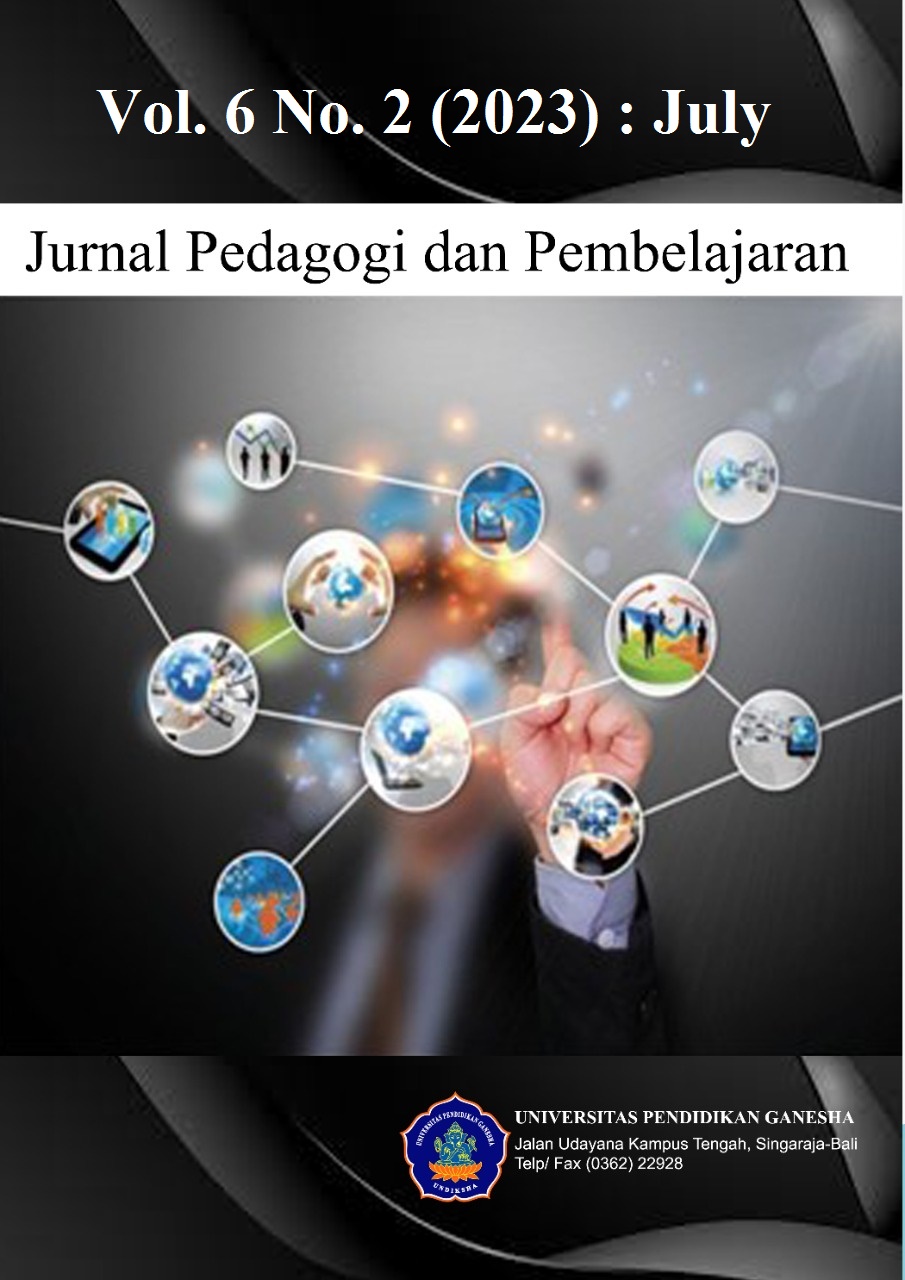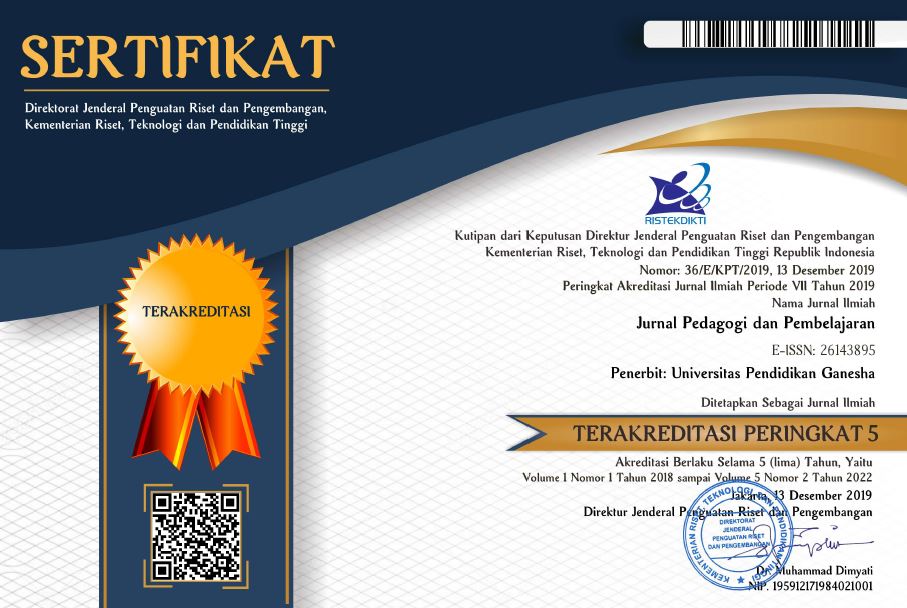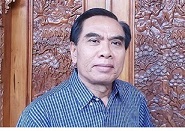Thematic Structure of Students’ Anecdote Text
DOI:
https://doi.org/10.23887/jp2.v6i2.62290Keywords:
Thematic Structure, Students’, Anecdote TextAbstract
The thematic structure (theme-rheme) is the starting point of the message and develops. A text cannot be separated from a clause, making it a complete text. The purpose of this research is to determine the theme used in student anecdotal texts depending on the level of achievement determined by the score. This type of research is qualitative. These students come from class A and are taking the second semester. Of the 15 texts selected for the exam, they have been divided into three categories based on their level of attainment. Methods of data collection using documentation. This study uses the data analysis method proposed by Krippendorff. Based on the findings of this study, the themes that appeared the most were Topical themes, which appeared 139 times (63%), and Textual themes, which appeared 67 times (31%). And Interpersonal themes appeared 14 times (6%). At the moderate level, the theme that appeared the most was the topical theme which appeared 119 times, followed by the textual theme with 46 occurrences, and the interpersonal theme with 11. At the lowest level, the topical theme appeared the most, with 87 occurrences (67%), followed by textual themes (34 occurrences (26%), and interpersonal themes (9 occurrences (7%). At a high level, dual themes became the dominant theme appearing 85 times (61%), while simple themes appeared 54 times (39%). At the medium level, the simple theme is more dominant than the double theme at the low level, with 46 occurrences (53%), while the dual theme has 41 occurrences (46%).
References
Ahrens, E., & Elias, M. (2023). Effective communication with linguistically diverse patients: A concept analysis. Patient Education and Counseling, 115. https://doi.org/10.1016/j.pec.2023.107868. DOI: https://doi.org/10.1016/j.pec.2023.107868
Akın, F., Koray, Ö., & Tavukçu, K. (2015). How Effective is Critical Reading in the Understanding of Scientific Texts? Procedia - Social and Behavioral Sciences, 174. https://doi.org/10.1016/j.sbspro.2015.01.915. DOI: https://doi.org/10.1016/j.sbspro.2015.01.915
Alexander, O. (2019). The contribution of Halliday to EAP writing instruction: A personal journey. Journal of English for Academic Purposes, 41. https://doi.org/10.1016/j.jeap.2019.100769. DOI: https://doi.org/10.1016/j.jeap.2019.100769
Alshawabkeh, A. A., Woolsey, M. L., & Kharbat, F. F. (2021). Using online information technology for deaf students during COVID-19: A closer look from experience. Heliyon, 7(5), e06915. https://doi.org/10.1016/j.heliyon.2021.e06915. DOI: https://doi.org/10.1016/j.heliyon.2021.e06915
Banks, D. (2010). The interpersonal metafunction in French from a Systemic Functional perspective. Language Sciences, 32(3). https://doi.org/10.1016/j.langsci.2009.06.002. DOI: https://doi.org/10.1016/j.langsci.2009.06.002
Carballo-Costa, L., Michaleff, Z. A., Costas, R., & Quintela-del-Río, A. (2022). Evolution of the thematic structure and main producers of physical therapy interventions research: A bibliometric analysis (1986 to 2017). Brazilian Journal of Physical Therapy, 26(4). https://doi.org/10.1016/j.bjpt.2022.100429. DOI: https://doi.org/10.1016/j.bjpt.2022.100429
Efransyah, E. (2018). Analyzing Thematic Structure In Indonesian Folktales In English Version: A Systemic Functional Grammar (SFG). PROJECT (Professional Journal of English Education), 1(2). https://doi.org/10.22460/project.v1i2.p85-94. DOI: https://doi.org/10.22460/project.v1i2.p85-94
Gai, M. Y. C. (2015). Motivational Factors in the Indonesian Efl Writing Classroom. Jurnal Pendidikan Bahasa dan Sastra, 15(1), 1. https://doi.org/10.17509/bs_jpbsp.v15i1.794. DOI: https://doi.org/10.17509/bs_jpbsp.v15i1.794
Gebhard, M., & Blaisdell, N. (2023). Systemic functional linguistic and disciplinary literacy development in multilingual K-12 schools in the United States. International Encyclopedia of Education. https://doi.org/10.1016/B978-0-12-818630-5.07001-9. DOI: https://doi.org/10.1016/B978-0-12-818630-5.07001-9
Gerot, & Wignell. (1994). Making Sense of Functional Grammar. Gerd Stabler, AEE Publishing.
Halliday, M. A. ., & Matthiessen. (2014). Halliday’s Introduction to Functional Grammar. Fourth Edition. Routledge. DOI: https://doi.org/10.4324/9780203783771
Jia, Y., & Yuan, X. (2023). Writing as Meaning‐Making: A Systemic Functional Linguistic Approach to EFL Writing, Winfred Wenhui Xuan , Springer (2022), p. 338, pp. Hardback. Journal of Second Language Writing, 60. https://doi.org/10.1016/j.jslw.2023.101011. DOI: https://doi.org/10.1016/j.jslw.2023.101011
Khalid, A., & Muhammad, K. (2012). The Use of YouTube in Teaching English Literature The Case of Al-Majma ’ ah Community College , Al-Majma ’ ah University ( Case Study ). International Journal of Linguistics, 4(4), 525–551. https://doi.org/10.5296/ijl.v4i4.2930. DOI: https://doi.org/10.5296/ijl.v4i4.2930
Lai, Y., & Kontokosta, C. E. (2019). Topic modeling to discover the thematic structure and spatial-temporal patterns of building renovation and adaptive reuse in cities. Computers, Environment and Urban Systems, 78. https://doi.org/10.1016/j.compenvurbsys.2019.101383. DOI: https://doi.org/10.1016/j.compenvurbsys.2019.101383
Marbun, M. (2017). The Analysis of Thematic Structure In TOEFL Test Reading Comprehension. University Of Sumatera Utara.
Mohebbi, H., & East, M. (2022). Dynamic assessment of students’ academic writing: Vygotskian and systemic functional linguistic perspectives, P.N. Shrestha. Journal of Second Language Writing, 58. https://doi.org/10.1016/j.jslw.2022.100899. DOI: https://doi.org/10.1016/j.jslw.2022.100899
Moses, R. N., & Mohamad, M. (2019). Challenges Faced by Students and Teachers on Writing Skills in ESL Contexts : A Literature Review. Journal Scientific Reseacrh, 10, 3385–3391. https://doi.org/10.4236/ce.2019.1013260. DOI: https://doi.org/10.4236/ce.2019.1013260
Ngongo, M. (2021). The investigation of modality and adjunct in spoken text of proposing a girl using Waijewa language based on Halliday’s systemic functional linguistic approach. ENGLISH REVIEW: Journal of English Education, 10(1). https://doi.org/10.25134/erjee.v10i1.5382.
Ngongo, Magdalena. (2021). the Investigation of Modality and Adjunct in Spoken Text of Proposing a Girl Using Waijewa Language Based on Halliday’s Systemic Functional Linguistic Approach. ENGLISH REVIEW: Journal of English Education, 10(1), 223–234. https://doi.org/0.25134/erjee.v10i1.5382. DOI: https://doi.org/10.25134/erjee.v10i1.5382
Nugroho, A., Ilmiani, D., & Rekha, A. (2021). EFL Teachers’ Challenges and Insights of Online Teaching amidst Global Pandemic. Metathesis: Journal of English Language, Literature, and Teaching, 4(3), 277. https://doi.org/10.31002/metathesis.v4i3.3195. DOI: https://doi.org/10.31002/metathesis.v4i3.3195
Rahnemoon, S. N., Ahangar, A. A., & Nourmohammadi, E. (2017). Thematic structure and translation: A case study of the translation of English news into Persian Author links open overlay panel. Lingua, 194. https://doi.org/10.1016/j.lingua.2017.05.003. DOI: https://doi.org/10.1016/j.lingua.2017.05.003
Rozumko, A. (2022). Textual functions of low confidence adverbs: The case of perhaps. Lingua, 268. https://doi.org/10.1016/j.lingua.2021.103191. DOI: https://doi.org/10.1016/j.lingua.2021.103191
Sinar, S., Zein, T., & Nurlela. (2021). Analysis in Courtroom Discourse by Using English Systemic Functional Linguistics. Asian EFL Journal June, 8(3).
Smart, J. (2019). Affordances of TOEFL writing tasks beyond university admissions. Assessing Writing, 41. https://doi.org/10.1016/j.asw.2019.06.006. DOI: https://doi.org/10.1016/j.asw.2019.06.006
Stosic, D. (2022). A linguistic construction of a research gap in reports of randomised controlled trials: A systemic functional perspective. Journal of English for Academic Purposes, 59. https://doi.org/10.1016/j.jeap.2022.101158. DOI: https://doi.org/10.1016/j.jeap.2022.101158
Suryati, A. (2020). Thematic Structures in The Text of English State Examination (Un) In Junior High School. State Islamic University of North Sumatera.
Tarigan, Sinar, Harefa, & Yusuf. (2014). Markedness of Theme in Everything, Everything Movie Dialog. CaLLs, 6(2). https://doi.org/10.30872/calls.v6i2.2332. DOI: https://doi.org/10.30872/calls.v6i2.2332
Undayasari, & Saleh. (2018). Comparison of Thematic Structure And Rogression Between English And Indonesia Exposition Text Written By Undergraduate Students Of UPI (Rhetorical Study). English journal education, 8(1).
Vinhto. (2018). Thematic Structure in Reading Comprehension Texts in English Textbooks. International Journal of Languages, Literature and Linguistics, 4(1). https://doi.org/10.18178/IJLLL.2018.4.1.148. DOI: https://doi.org/10.18178/IJLLL.2018.4.1.148
Downloads
Published
How to Cite
Issue
Section
License
Copyright (c) 2023 Mahriyuni, Tengku Silvana Sinar, Nurhaliza

This work is licensed under a Creative Commons Attribution-ShareAlike 4.0 International License.
Authors who publish with Jurnal Pedagogi dan Pembelajaran agree to the following terms:- Authors retain copyright and grant the journal the right of first publication with the work simultaneously licensed under a Creative Commons Attribution License (CC BY-SA 4.0) that allows others to share the work with an acknowledgment of the work's authorship and initial publication in this journal
- Authors are able to enter into separate, additional contractual arrangements for the non-exclusive distribution of the journal's published version of the work (e.g., post it to an institutional repository or publish it in a book), with an acknowledgment of its initial publication in this journal.
- Authors are permitted and encouraged to post their work online (e.g., in institutional repositories or on their website) prior to and during the submission process, as it can lead to productive exchanges, as well as earlier and greater citation of published work. (See The Effect of Open Access)













